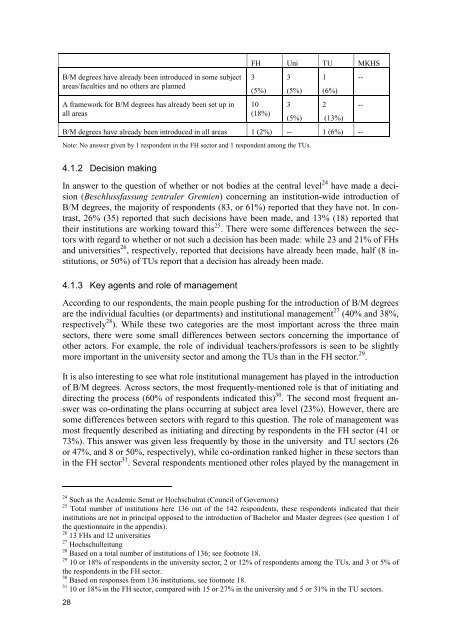and Master Programmes in German Higher Education Institutions
and Master Programmes in German Higher Education Institutions
and Master Programmes in German Higher Education Institutions
- No tags were found...
You also want an ePaper? Increase the reach of your titles
YUMPU automatically turns print PDFs into web optimized ePapers that Google loves.
B/M degrees have already been <strong>in</strong>troduced <strong>in</strong> some subjectareas/faculties <strong>and</strong> no others are plannedA framework for B/M degrees has already been set up <strong>in</strong>all areasFH Uni TU MKHS3(5%)10(18%)3(5%)3(5%)1(6%)2(13%)B/M degrees have already been <strong>in</strong>troduced <strong>in</strong> all areas 1 (2%) -- 1 (6%) --Note: No answer given by 1 respondent <strong>in</strong> the FH sector <strong>and</strong> 1 respondent among the TUs.----4.1.2 Decision mak<strong>in</strong>gIn answer to the question of whether or not bodies at the central level 24 have made a decision(Beschlussfassung zentraler Gremien) concern<strong>in</strong>g an <strong>in</strong>stitution-wide <strong>in</strong>troduction ofB/M degrees, the majority of respondents (83, or 61%) reported that they have not. In contrast,26% (35) reported that such decisions have been made, <strong>and</strong> 13% (18) reported thattheir <strong>in</strong>stitutions are work<strong>in</strong>g toward this 25 . There were some differences between the sectorswith regard to whether or not such a decision has been made: while 23 <strong>and</strong> 21% of FHs<strong>and</strong> universities 26 , respectively, reported that decisions have already been made, half (8 <strong>in</strong>stitutions,or 50%) of TUs report that a decision has already been made.4.1.3 Key agents <strong>and</strong> role of managementAccord<strong>in</strong>g to our respondents, the ma<strong>in</strong> people push<strong>in</strong>g for the <strong>in</strong>troduction of B/M degreesare the <strong>in</strong>dividual faculties (or departments) <strong>and</strong> <strong>in</strong>stitutional management 27 (40% <strong>and</strong> 38%,respectively 28 ). While these two categories are the most important across the three ma<strong>in</strong>sectors, there were some small differences between sectors concern<strong>in</strong>g the importance ofother actors. For example, the role of <strong>in</strong>dividual teachers/professors is seen to be slightlymore important <strong>in</strong> the university sector <strong>and</strong> among the TUs than <strong>in</strong> the FH sector. 29 .It is also <strong>in</strong>terest<strong>in</strong>g to see what role <strong>in</strong>stitutional management has played <strong>in</strong> the <strong>in</strong>troductionof B/M degrees. Across sectors, the most frequently-mentioned role is that of <strong>in</strong>itiat<strong>in</strong>g <strong>and</strong>direct<strong>in</strong>g the process (60% of respondents <strong>in</strong>dicated this) 30 . The second most frequent answerwas co-ord<strong>in</strong>at<strong>in</strong>g the plans occurr<strong>in</strong>g at subject area level (23%). However, there aresome differences between sectors with regard to this question. The role of management wasmost frequently described as <strong>in</strong>itiat<strong>in</strong>g <strong>and</strong> direct<strong>in</strong>g by respondents <strong>in</strong> the FH sector (41 or73%). This answer was given less frequently by those <strong>in</strong> the university <strong>and</strong> TU sectors (26or 47%, <strong>and</strong> 8 or 50%, respectively), while co-ord<strong>in</strong>ation ranked higher <strong>in</strong> these sectors than<strong>in</strong> the FH sector 31 . Several respondents mentioned other roles played by the management <strong>in</strong>24 Such as the Academic Senat or Hochschulrat (Council of Governors)25 Total number of <strong>in</strong>stitutions here 136 out of the 142 respondents, these respondents <strong>in</strong>dicated that their<strong>in</strong>stitutions are not <strong>in</strong> pr<strong>in</strong>cipal opposed to the <strong>in</strong>troduction of Bachelor <strong>and</strong> <strong>Master</strong> degrees (see question 1 ofthe questionnaire <strong>in</strong> the appendix).26 13 FHs <strong>and</strong> 12 universities27 Hochschulleitung28 Based on a total number of <strong>in</strong>stitutions of 136; see footnote 18.29 10 or 18% of respondents <strong>in</strong> the university sector, 2 or 12% of respondents among the TUs, <strong>and</strong> 3 or 5% ofthe respondents <strong>in</strong> the FH sector.30 Based on responses from 136 <strong>in</strong>stitutions, see footnote 18.31 10 or 18% <strong>in</strong> the FH sector, compared with 15 or 27% <strong>in</strong> the university <strong>and</strong> 5 or 31% <strong>in</strong> the TU sectors.28
















